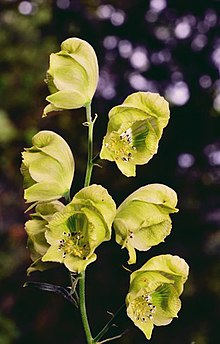Monkshood
| Monkshood | ||||||||||||
|---|---|---|---|---|---|---|---|---|---|---|---|---|

Colored monkshood ( Aconitum variegatum ) |
||||||||||||
| Systematics | ||||||||||||
|
||||||||||||
| Scientific name | ||||||||||||
| Aconite | ||||||||||||
| L. |
The plant genus Eisenhut ( Aconitum ), also monkshood , aconite , formerly Wolf Wurz , belongs to the family of the buttercup family (Ranunculaceae).
The term monkshood is derived from the helmet-like flower shape. The blue monkshood ( Aconitum napellus ) was voted poisonous plant of the year in 2005 .
description
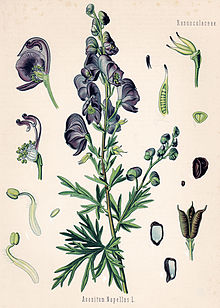
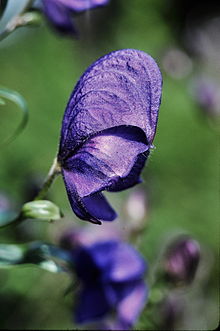



Appearance and leaves
In Aconitum TYPES is mostly perennial , or pseudoeinjährige, rarely annual herbaceous plants . A taproot or two or more beet-like thickened roots are formed. The stems grow upright or climbing on their own.
The foliage leaves , sometimes all arranged in a basal rosette and mostly alternately distributed on the stem, are often divided into petiole and leaf blade; where the uppermost leaves are often more or less sessile. The leaf blades are usually divided palmately with three to seven leaf sections or rarely undivided. The uppermost leaf sections are narrow-elliptical or lanceolate to linear with incised and serrated leaf margins.
Inflorescences and flowers
In terminal and sometimes lateral, up to 28 centimeters long, simple or mostly branched, racemose or paniculate inflorescences , the stalked flowers stand together over two bracts ; there may be 32 or more partial inflorescences. The bracts are similar to foliage.
The hermaphrodite flowers are zygomorphic and five-fold. The five blue, yellow or white sepals are characteristic . The two lower sepals are relatively small with a length of 6 to 20 millimeters, flat and narrowly lanceolate or oblong. The two lateral sepals are almost circular to kidney-shaped. The large, upper and 1 to 5 centimeter long, sickle, boat and helmet-shaped to cylindrical sepal includes two honey leaves (modified petals, the other six are greatly reduced or completely absent) and overlaps the two lateral sepals. The free, long- nailed honey leaves, which are cap- or tongue-shaped at the top, have capped or rolled-up spurs at their upper end that contain nectar . The many (25 to 50) fertile stamens consist of stamens widened at their base and ellipsoidal to spherical anthers. There are no staminodes . The three to five, rarely up to thirteen free carpels each contain ten to twenty ovules . The short stylus has a long shelf life.
Fruits and seeds
In Sammelbalgfrüchten several sessile sit follicles together. On the elongated follicles, clearly raised transverse nerves can be seen on the sides. At the end of each follicle there is a straight beak 2 to 3 millimeters long. The mostly relatively small seeds are delta-shaped and usually have transverse, small, membranous lamellae.
Sets of chromosomes
The basic chromosome number is x = 8. There are types with diploidy and those with polyploidy .
Health hazards
The monkshood species are among the most poisonous plants in Europe , they contain toxic diterpenes - alkaloids that are found in all parts of the plant. Essentially, these are the alkaloids aconitine , benzoylnaponine , hypaconitine , lycaconitine and neopelline , and the amino alcohols aconine , napelline , neoline and lycoctonine , which can be detected in different concentrations. In addition, some species also contain isoquinoline alkaloids or catecholamines .
The toxicity depends on the monkshood species, the site conditions and the genetic factors of the individual plant. The aconitine is quickly absorbed through the uninjured skin , and this is especially true for the mucous membranes , so that children are at risk if, for example, they play with the flowers. Touching people with delicate skin can lead to hives . Consumption of a few grams of the plant usually leads to heart failure and respiratory failure ; no specific antidote is known.
The plant name Wolfswurz originated from the use of monkshood as a wolf poison.
Systematics and distribution


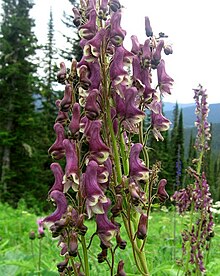


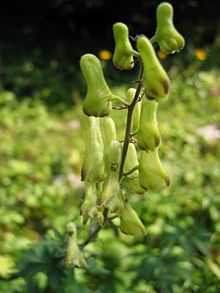




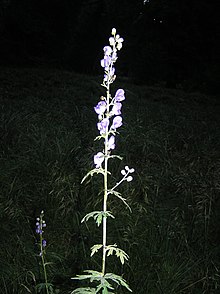

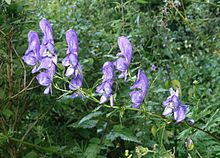
The genus Aconitum was established in 1753 by Carl von Linné in Species Plantarum , 1, p. 532. The genus Aconitum belongs to the tribe Delphinieae in the subfamily of Ranunculoideae within the family of Ranunculaceae .
The genus Aconitum is considered an Arctic genus from the Tertiary , which spread from Siberia over Europe, Asia and America, whereby the ice ages are considered to be the trigger for the vegetal migration . Around half of the 400 or so valid species occur in China (211 species, 166 of which are only there).
In Central Europe , the two species of blue monkshood ( Aconitum napellus ) and monkshood ( Aconitum variegatum ) as well as the yellow-flowered wolf monkshood ( Aconitum lycoctonum subsp. Vulparia ) are most widespread; they are under nature protection .
The genus monkshood ( aconite ) contains around (100 to 400 species, depending on the author):
- Aconitum abietenorum W.T.Wang & LQLi
- Aconitum acutiusculum H.R. Fletcher & Lauener : There are two varieties.
- Aconitum alboflavidum W.T.Wang
- White-violet monkshood ( Aconitum alboviolaceum Kom. ): The varieties are widespread in East Asia.
- Aconitum alpinonepalense Tamura
- Aconitum altaicum Steinb.
- Aconitum ambiguum Rchb.
- Aconitum amplexicaule Lauener
- Aconitum angulatum Tamura
- Aconitum angusticassidatum Steinb.
- Aconitum angustifolium Bernh. ex Rchb.
- Poison monkshood ( Aconitum anthora L. ): It is common in Eurasia .
- Aconitum anthoroideum DC.
- Aconitum apetalum (Huth) B.Fedtsch.
- Aconitum aquilonare A. Kern. ex Gáyer
- Aconitum artemisiifolium A.I.Baranov & Skvortsov
- Aconitum assamicum Lauener
- Aconitum atlanticum Coss.
- Aconitum austrokoreense Koidz.
- Aconitum austroyunnanense W.T.Wang
- Aconitum axilliflorum Vorosch.
- Aconitum azumiense Kadota & Hashido
- Aconitum baburinii (Vorosch.) Schlotgauer
- Aconitum baicalense Turcz. ex Rapaics ; Home: Siberia
- Aconitum bailangense Y.Z.Zhao
- Aconitum balfourii Stapf : subalpine zones in the Indian Himalayas between 3000 and 4300 m above sea level
- Aconitum barbatum Patrin ex Pers. : The three varieties arewidespread inChina, Russia's Far East, and Siberia .
- Aconitum bhedingense Lauener
- Aconitum bhutanobulbilliferum Kadota
- Aconitum biflorum fish. ex DC.
- Aconitum birobidshanicum Vorosch.
- Aconitum brachypodum Diels : The three varieties thrive on grassy slopes and mountains at altitudes of 2800 to 4300 meters in the Chinese provinces of Sichuan and Yunnan.
- Aconitum bracteolatum Lauener
- Aconitum bracteolosum W.T.Wang
- Aconitum brevicalcaratum (Finet & Gagnep.) Diels : There are two varieties.
- Aconitum brevilimbum Lauener
- Aconitum brevipetalum W.T.Wang
- Aconitum brunneum Hand.-Mazz.
- Aconitum bucovinense Zapał.
- Aconitum bulbilliferum Hand .-- Mazz.
- Aconitum bulleyanum Diels
- Aconitum burnatii Gáyer
- Aconitum × cammarum L. (= A. napellus × A. variegatum )
- Aconitum calthifolium Comber
- Aconitum campylorrhynchum Hand .-- Mazz.
- Aconitum cannabifolium Franch. ex Finet & Gagnep.
-
Aconitum carmichaelii Debeaux (Syn .: Aconitum jiulongense W.T.Wang ): The five varieties are widespread in northern Vietnam and China:
- Aconitum carmichaelii Debeaux var. Carmichaelii (Syn .: Aconitum bodinieri H.Lév. & Vaniot , Aconitum Kusnezoffii var. Bodinieri (H.Lév. & Vaniot) Finet & Gagnep. , Aconitum lushanense Migo )
- Aconitum carmichaelii var. Hwangshanicum (WTWang & PKHsiao) WTWang & PKHsiao
- Aconitum carmichaelii var. Pubescens W.T.Wang & PKHsiao
- Aconitum carmichaelii var. Tripartitum W.T.Wang : It occurs only in Jiangsu .
- Chinese monkshood ( Aconitum carmichaelii var. Truppelianum (Ulbrich) WTWang & PKHsiao , Syn .: Aconitum chinense Paxton , Aconitum japonicum var. Truppelianum Ulbr. , Aconitum carmichaelii var. Fortunei (Hemsley) WTWang & PKHsiao , Aconitum fortunei Hemsley , Aconitum kitagawae Nakai , Aconitum liaotungense Nakai , Aconitum takahashii Kitagawa , Aconitum truppelianum (Ulbrich) Nakai )
- Aconitum cavaleriei H.Lév. & Vaniot : There are two varieties.
- Aconitum changianum W.T.Wang
- Aconitum charkeviczii Vorosch.
- Aconitum chasmanthum Stapf ex Holmes
- Aconitum chayuense W.T.Wang
- Aconitum chiachaense W.T.Wang
- Aconitum chiisanense Nakai
- Aconitum chilienshanicum W.T.Wang
- Aconitum chloranthum Hand.-Mazz.
- Aconitum chrysotrichum W.T.Wang
- Aconitum chuanum W.T.Wang
- Aconitum chuosjiaense W.T.Wang
- Aconitum cochleare Vorosch.
- Aconitum columbianum Nutt. (Syn .: Aconitum leibergii Greene , Aconitum mogollonicum Greene , Aconitum noveboracense A. Gray ex Coville , Aconitum viviparum Greene ): It is widespread with two varieties mainly in western North America and is also found in Mexico.
- Aconitum consanguineum Vorosch.
- Aconitum contortum Finet & Gagnep.
- Aconitum contractum Vorosch.
- Aconitum coreanum (H.Lév.) Rapaics (Syn .: Aconitum delavayi var. Coreanum H.Lév ): It is common in Korea, Mongolia, Russia's Far East and in the Chinese provinces of northern Hebei, eastern Heilongjiang , Jilin, Liaoning .
- Aconitum coriaceifolium W.T.Wang
- Aconitum coriophyllum Hand.-Mazz.
- Aconitum crassicaule W.T.Wang
- Aconitum crassiflorum Hand .-- Mazz.
- Aconitum crassifolium Steinb.
- Aconitum creagromorphum Lauener
- Aconitum curvipilum Riedl
- Aconitum cymbulatum (Schmalh.) Lipsky
- Aconitum daxinganlinense Y.Z.Zhao
- Aconitum decipiens Vorosch. & Anfalov
-
Degens monkshood ( Aconitum degenii Gáyer ): There are several subspecies:
- Aconitum degenii Gáyer subsp. degenii ; Home: Romania and Russia
- Rispiger Eisenhut ( Aconitum degenii subsp. Paniculatum (Arcang.) Mucher , Syn .: Aconitum paniculatum auct.); Home: Mountains of Europe
- Aconitum delavayi Franch.
- Aconitum delphiniifolium DC.
- Aconitum desoulavyi Kom.
- Aconitum dhwojii Lauener
- Aconitum diqingens Q.E.Yang & ZDFang
- Aconitum dissectum D.Don
- Aconitum dolichorhynchum W.T.Wang
- Aconitum dolichostachyum W.T.Wang
- Aconitum duclouxii H.Lév. : There are two varieties.
- Aconitum dunhuaense S.H.Li
- Aconitum elliotii Lauener : The four varieties occur in eastern Tibet.
- Aconitum elwesii Stapf
- Aconitum episcopale H.Lév. : There are two varieties in the Chinese provinces of western Guizhou, southwest Sichuan and Yunnan.
- Aconitum falciform hand .-- Mazz.
- Aconitum fangianum W.T.Wang
- Aconitum fanjingshanicum W.T.Wang
- Aconitum finetianum Hand.-Mazz. (Syn .: Aconitum sioseanum Migo )
- Himalayan monkshood ( Aconitum ferox Wall. Ex Ser. ); Home: Himalayas
- Aconitum firmum Rchb.
- Aconitum fischeri Rchb. (Syn .: Aconitum arcuatum Maxim. , Aconitum sinense Sieb. Ex Lindl. & Paxton ): There are two varieties in Korea, Russia's Far East and in the Chinese provinces of Heilongjiang and Jilin .
- Aconitum flavum Hand .-- Mazz.
- Aconitum fletcherianum G.Taylor
- Aconitum formosanum Tamura
- Aconitum forrestii Stapf : There are two varieties in the Chinese provinces of southwest Sichuan and northwest Yunnan.
- Aconitum franchetii Finet & Gagnep.
- Aconitum fukutomei Hayata
- Aconitum funiculare Stapf
- Aconitum fusungense Sheng Hao Li & Yun Hui Huang : This endemic thrives on grassy slopes at altitudes of around 900 meters only in Fusong Xian in Jilin.
- Aconitum gammiei Stapf (Syn .: Aconitum huizenense T.L.Ming , Aconitum nakaoi Lauener , Aconitum parabrachypodum Lauener )
- Aconitum gassanense Kadota & Sh.Kato
- Aconitum geniculatum H.R. Fletcher & Lauener : It occurs in four varieties in the Chinese provinces of Sichuan and Yunnan.
- Aconitum georgei Comber : It is endemic to northwestern Yunnan.
- Aconitum gezaense W.T.Wang & LQLi : It is endemic to northwestern Yunnan.
- Aconitum gigas H.Lév. & Vaniot
- Aconitum glabrisepalum W.T.Wang : It is endemic to Kangding Xian in western Sichuan.
- Aconitum gubanovii Luferov & Vorosh.
- Aconitum gymnandrum Maxim. : It is common in Tibet and the Chinese provinces of southern Gansu, Qinghai, western Sichuan and possibly Yunnan.
- Aconitum habaense W.T.Wang : It is endemic to northwestern Yunnan.
- Aconitum hamatipetalum W.T.Wang : It is endemic to northwestern Yunnan.
- Aconitum handelianum H.F.Comber : It occurs in four varieties in the Chinese provinces of northwestern to western Sichuan and northwestern Yunnan.
- Aconitum helenae Vorosch.
- Aconitum hemsleyanum E. Pritz. : The eleven varieties are common in Myanmar and China.
- Henry monkshood ( Aconitum henryi E. Pritz. ): The four varieties are common in the Chinese provinces of southern Gansu, western Henan, Hubei, northwestern Hunan, southeastern Shaanxi, southern Shanxi, Sichuan and western Zhejiang.
- Aconitum heterophylloides (Brühl) Stapf
- Aconitum heterophyllum Wall. ex Royle ; Home: India, Nepal, Pakistan
- Aconitum hicksii Lauener
- Aconitum hookeri Stapf
- Aconitum hopeiense (WTWang) Vorosch.
- Aconitum huiliense Hand.-Mazz. : It is endemic to Huili Xian in southwest Sichuan.
- Aconitum ichangense (Finet & Gagnep.) Hand.-Mazz.
- Aconitum iidemontanum Kadota, Kita & Ueda
- Aconitum incisofidum W.T.Wang
- Aconitum infectum Greene
- Aconitum iochanicum Ulbr. : It is endemic to northwestern Yunnan.
- Aconitum iranshahrii Riedl
- Aconitum jaluense Kom .: The three varieties are common in Korea, Russia's Far East and in the Chinese provinces of Heilongjiang , Jilin and southeast Liaoning .
- Aconitum japonicum Thunb. : The two subspecies are common in Japan, Korea, and Liaoning Province, China.
- Aconitum jeholense Nakai & Kitag. There are two varieties.
- Aconitum jenisseense Polozhij : It is endemic to Gyirong Xian in Tibet.
- Aconitum jilongense W.T.Wang & LQLi
- Aconitum jin-muratae Kadota & Nob.Tanaka
- Aconitum kagerpuense W.T.Wang
- Aconitum kaimaense Uyeki & Sakata
- Aconitum kamelinii A.A. Solovjev
- Aconitum karafutense Miyabe & Nakai
- Aconitum karakolicum Rapaics : There are two varieties.
- Aconitum khanminthunii A.A. Solovjev & Shmakov
- Aconitum kialaense W.T.Wang
- Aconitum kirghistanicum Kadota
- Aconitum kirinense Nakai : The three varieties are common in Russia's Far East and China.
- Aconitum kitadakense Nakai
- Aconitum kiyomiense Kadota
- Aconitum kojimae Ohwi ex Tamura : The two varieties occur in southern Taiwan.
- Aconitum komarovianum Nakai
- Aconitum kongboense Lauener : There are three varieties in China.
- Aconitum korshinskyi Tzvelev
- Aconitum krasnoboroffii Kadota
- Aconitum krylovii Steinb. ; Home: Western Siberia
- Aconitum kunasilense Nakai
- Aconitum kungshanense W.T.Wang
- Aconitum kurramense Qureshi & Chaudhri
- Aconitum kusnezoffii Rchb. : There are three varieties in China, Korea and Siberia.
- Aconitum kuzenevae Vorosch.
- Aconitum laeve Royle
- Aconitum laevicaule W.T.Wang : It is endemic to Zhongdian Xian in northwestern Yunnan.
- Aconitum lamarckii Rchb.
- Aconitum lasiocarpum (Rchb.) Gáyer
- Aconitum lasiostomum Rchb. ex better
- Aconitum legendrei Hand.-Mazz. : It is endemic to Mianning Xian in southwest Sichuan.
- Aconitum leiostachyum W.T.Wang : It is endemic to Li Xian in north-central Sichuan.
- Aconitum leiwuqiense W.T.Wang : It is endemic to the Riwoqê Xian in Tibet.
- Aconite lethal handle.
- Aconitum leucostomum Vorosch. : There are several varieties (selection) in China, Kazakhstan , Kyrgyzstan , Mongolia and western Siberia:
- Aconitum liangshanicum W.T.Wang : It is endemic to Yuexi Xian in southwest Sichuan.
- Aconitum lihsienense W.T.Wang : It is endemic to Li Xian in north-central Sichuan.
- Aconitum liljestrandii Hand .-- Mazz. : There are two varieties in eastern Tibet and western Sichuan.
- Aconitum limprichtii Hand .-- Mazz.
- Aconitum lioui W.T.Wang : It is endemic to Taibai Shan in Shaanxi.
- Aconitum lobulatum W.T.Wang : It is endemic to Muli Zang Zu Zizhi Xian in western Sichuan.
- Aconitum loczyanum Rapaics
- Aconitum lonchodontum Hand.-Mazz. : It thrives on mountains at altitudes of around 2800 meters only in western Hubei.
- Aconitum longecassidatum Nakai
- Aconitum longilobum W.T.Wang : It is endemic to the Nyingchi Xian in eastern Tibet.
- Aconitum longipedicellatum Lauener : It occurs only in southeastern Tibet.
- Aconitum longipetiolatum Lauener : It occurs only in southeastern Tibet.
- Aconitum longiracemosum Vorosch. : It only occurs in western Sichuan.
- Aconitum ludlowii Exell : It is endemic to Gyangzê Xian in Tibet.
- Aconitum luningense W.T.Wang : It is endemic to Mianning Xian in Sichuan.
- Aconitum lycoctonifolium W.T.Wang & LQLi : It is endemic to the Mêdog Xian in Tibet.
-
Aconitum lycoctonum L .: There are several subspecies (selection):
- Yellow monkshood ( Aconitum lycoctonum subsp. Lycoctonum , Syn .: Aconitum excelsum Rchb. , Aconitum septentrionale Koelle ); Home: Europe
- Wolf monkshood ( Aconitum lycoctonum subsp. Vulparia (Rchb.) Nyman , Syn .: Aconitum lycoctonum auct., Aconitum vulparia Rchb. ); Home: Europe
- Aconitum macrorhynchum Turcz. ex Ledeb.
- Aconitum magnibracteolatum W.T.Wang : It is endemic to the Yanbian Xian in western Sichuan.
- Aconitum maowenense W.T.Wang : It is endemic to Maowen Qiang Zu Zizhixian in Sichuan.
- Aconitum mashikense Kadota & S.Umezawa
- Aconitum maximum Pall. ex DC.
- Aconitum milinense W.T.Wang : It is endemic to the mainling Xian in eastern Tibet.
- Aconitum miyabei Nakai
- Aconitum moldavicum Hacq.
- Aconitum monanthum Nakai
- Aconitum montibaicalense Vorosch.
- Aconitum monticola Steinb.
- Aconitum moschatum (Brühl) Stapf
- Aconitum nagarum Stapf (Syn .: Aconitum dielsianum Airy Shaw ): The three varieties are distributed from northeastern India ( Assam ) through northern Myanmar to Yunnan.
- Aconitum nakaoi Tamura
- Aconitum namlaense W.T.Wang (it could be a synonym of Aconitum stapfianum ): It is endemic near Nanjiabawa Shan in Tibet.
- Blue monkshood ( Aconitum napellus L. ): It is common in Europe.
- Aconitum nasutum fish. ex Rchb.
- Aconitum naviculare (Brühl) Stapf : It is common in Sikkim, Bhutan and southern Tibet.
- Aconitum nemorum Popov : It is common in Central Asia, for example in the Chinese Xinjiang.
- Aconitum neosachalinense H.Lév.
- Aconitum neotortuosum Nakai
- Aconitum nielamuense W.T.Wang : It is endemic to Nyalam Xian in southern Tibet.
- Aconitum ningwuense W.T.Wang : It is endemic to Ningwu Xian in Shanxi.
- Aconitum nipponicum Nakai
- Aconitum noveboracense A. Gray ex Coville
- Aconitum novoluridum Munz : It is common in Sikkim, Bhutan, Nepal and southeastern Tibet.
- Aconitum nutantiflorum P.K.Chang ex WTWang : It is endemic to the Zayü Xian in southeastern Tibet.
- Aconitum ochotense Rchb.
- Aconitum okuyamae Nakai
- Aconitum orientale Mill .: It iswidespreadfrom the Caucasus region via Turkey to Iran.
- Aconitum orochryseum Stapf
- Aconitum ouvrardianum Hand .-- Mazz. : The three varieties since 2004 occur in the Zayu Xian in southeastern Tibet and in Yunnan.
- Aconitum palmatum D. Don
-
Aconitum paniculigerum Nakai : There are two varieties:
- Aconitum paniculigerum Nakai var. Paniculigerum : It is common in Korea and the Chinese provinces of eastern Jilin and southeastern Liaoning .
- Aconitum paniculigerum var. Wulingense (Nakai) WTWang (Syn .: Aconitum wulingense Nakai, Aconitum kusnezoffii var. Wulingense (Nakai) WTWang , Aconitum tokii Nakai ): It occurs only in northeastern Hebei.
- Aconitum paradoxum Rchb.
- Aconitum parcifolium Q.E.Yang & ZDFang : It is endemic to Weixi Lisu Zu Zizhixian in northwestern Yunnan.
- Aconitum paskoi Vorosch.
- Aconitum pavlovae Vorosch.
- Aconitum pendulicarpum P.K.Chang ex WTWang : The two varieties occur in southeastern Tibet and northwestern Yunnan.
- Aconitum pendulum N.Busch (Syn .: Aconitum szechenyianum Gáyer ): It is found in southern Gansu, western Henan, Qinghai, southern Shanxi, western Sichuan, northwestern Yunnan and Tibet.
- Aconitum pentheri Hayek
- Aconitum phyllostegium Hand.-Mazz. : The two varieties are endemic to Muli Zang Zu Zizhixian in southwest Sichuan.
- Aconitum piepunense Hand.-Mazz. : The two varieties are endemic to Zhongdian Xian in northwestern Yunnan.
- Raustieliger monkshood ( Aconitum × pilipes (Rchb.) Gáyer ); Home: Alps
- Aconitum pilopetalum W.T.Wang & LQLi : It is endemic to the Yajiang Xian in western Sichuan.
- Folded monkshood , gaping monkshood or Sudeten monkshood ( Aconitum plicatum Koehler ex Rchb. ); Home: Austria , Sudeten , Ore Mountains , Fichtel Mountains , Bavarian Forest
-
Aconitum polyanthum (Finet & Gagnep.) Hand.-Mazz. : There are two varieties:
- Aconitum polyanthum (Finet & Gagnepain) Hand.-Mazz. var. polyanthum : It occurs only in western Sichuan.
- Aconitum polyanthum var. Puberulum W.T.Wang : It is endemic to Dêngqên Xian in eastern Tibet.
- Aconitum poluninii Lauener
- Aconitum polycarpum P.K.Chang ex WTWang : It is endemic to Bijiang Xian in northwestern Yunnan.
- Aconitum polyschistum Hand.-Mazz. : It occurs only in northwest to western Sichuan.
- Aconitum pomeense W.T.Wang : It is endemic to Bomi Xian in eastern Tibet.
- Aconitum popovii Steinb. & Schischk. ex Siplivinskii
- Aconitum potaninii Kom .: It occurs only in western Sichuan.
- Aconitum productum Rchb.
- Aconitum proliferum Nakai
- Aconitum prominens Lauener : It occurs only in eastern Tibet.
- Aconitum pseudobrunneum W.T.Wang : It is endemic to Xiangcheng Xian in western Sichuan.
- Aconitum pseudodivaricatum W.T.Wang : It is endemic to Bomi Xian in eastern Tibet.
- Aconitum pseudogeniculatum W.T.Wang : The two varieties are endemic to western Sichuan.
- Aconitum pseudohuiliense Chang ex WTWang : It is endemic to Leibo Xian in Sichuan.
- Aconitum pseudokongboense W.T.Wang & LQLi : It is endemic to Gongbo'gyamda Xian in Tibet.
- Aconitum pseudokusnezowii Vorosch.
- Aconitum pseudolaeve Nakai
- Aconitum pseudoproliferum Nakai
- Aconitum pseudosessiliflorum Lauener
- Aconitum pseudostapfianum W.T.Wang (Syn .: Aconitum tuguancunense Q.E.Yang ): It is endemic to the Lijiang Naxi Zu Zizhi Xian in northwestern Yunnan.
- Aconitum pterocaule Koidz.
- Aconitum pteropus Nakai
- Aconitum puchonroenicum Uyeki & Sakata
- Aconitum pukeense W.T.Wang : There are two varieties in Sichuan and northeastern Yunnan.
- Aconitum pulchellum Hand.-Mazz. : There are three varieties.
- Aconitum pycnanthum W.T.Wang : It is endemic to Muli Zang Zu Zizhi Xian in southwest Sichuan.
- Aconitum quelpaertense Nakai
- Aconitum qinghaiense Kadota : It occurs in southeastern Tibet, southwestern Gansu and southeastern Qinghai .
- Aconitum racemulosum Franch. : There are two varieties in the Chinese provinces of Guizhou, western Hubei, Sichuan and northeastern Yunnan.
- Aconitum raddeanum rule : It thrives on mountains in Russia's Far East and in Yichun Shi in Heilongjiang and in Dunhua Xian in Jilin.
- Aconitum ramulosum W.T.Wang : It is endemic to Zhongdian Xian in northwestern Yunnan.
- Aconitum ranunculoides Turcz. : It thrives on grasslands in Russia's Far East, Siberia and Ergun Zuoqi in Nei Mongol.
- Aconitum reclinatum A.Gray (Syn .: Aconitum vaccarum Rydb. ): It is distributed in the eastern US states of southwestern Pennsylvania , eastern West Virginia , western North Carolina and northern to western Virginia .
- Aconitum refracticarpum P.K.Chang ex WTWang : It is endemic to Bijiang Xian in northwestern Yunnan.
- Aconitum refractum (Finet & Gagnep.) Hand.-Mazz. (Syn .: Aconitum napellus var. Refractum Finet & Gagnep. , Aconitum angustisegmentum W.T.Wang ): It thrives on grassy slopes in Karub in Tibet and in western Sichuan.
- Aconitum rhombifolium F.H.Chen : The two varieties only occur in Sichuan.
- Aconitum richardsonianum Lauener : The two varieties occur only in eastern Tibet.
- Aconitum rilongense Kadota : It is endemic to Xiaojin Xian in central Sichuan.
- Aconitum rockii H.R. Fletcher & Lauener : The two varieties occur only in northwestern Yunnan.
- Aconitum rotundifolium Kar. & Kir. : It is common in Central Asia, for example Xinjiang.
- Aconitum rubicundum fish. ex Steud.
- Aconitum sachalinense F.Schmidt
- Aconitum saitoanum Ohwi
- Aconitum sajanense Kuminova
- Aconitum saxatile Vorosch. & Vorob.
- Aconitum scaposum Franch. : The three varieties are distributed in Bhutan, Nepal, northern Myanmar and in the Chinese provinces of southern Gansu, Guizhou, southwestern Henan, Hubei, northern Hunan, Jiangxi, southern Shaanxi, Sichuan, northern to northeastern Yunnan.
- Aconitum sczukinii Turcz. : It is common in Russia's Far East and in the Chinese provinces of Heilongjiang, Jilin and Liaoning.
- Aconitum secundiflorum W.T.Wang : It is endemic to Maowen Qiang Zu Zizhi Xian in Sichuan.
- Aconitum senanense Nakai
- Aconitum seoulense Nakai
- Aconitum septentrionale Koelle : It is common in Europe, Siberia , Mongolia and the Chinese provinces of Heilongjiang and northwestern Liaoning .
- Aconitum seravschanicum Steinb.
- Aconitum sessiliflorum (Finet & Gagnep.) Hand.-Mazz. (Syn .: Aconitum napellus var. Sessiliflorum Finet & Gagnep. , Aconitum rotundifolium var. Sessiliflorum (Finet & Gagnep.) Rapaics ): It occurs in western Sichuan and perhaps in Yunnan.
- Aconitum shennongjiaense Q.Gao & QEYang : It was first described in 2009 from the Shennongjia nature reserve in Hubei.
- Aconitum shensiense W.T.Wang : It is endemic to Zhouzhi Xian in Shaanxi.
- Aconitum sherriffii Lauener
- Aconitum shimianense W.T.Wang : It is endemic to Shimian Xian in Sichuan.
- Aconitum sichotense Kom.
- Aconitum sinchiangense W.T.Wang : It occurs in Xinjiang.
- Aconitum sinoaxillare W.T.Wang : It is endemic to Bomi Xian in eastern Tibet.
- Aconitum sinomontanum Nakai : The three varieties are widespread in China.
- Aconitum smirnovii Steinb. : It is common in central Siberia, Mongolia and Burqin Xian in Xinjiang.
- Aconitum smithii Ulbr. ex Hand.-Mazz. : It occurs in the Chinese provinces of western Hebei and Shanxi.
- Aconitum soongaricum (rule) Stapf : It occurs in Central Asia, for example Kashmir and Xinjiang.
- Aconitum souliei Finet & Gagnep. : It occurs only in northwestern Yunnan.
- Aconitum soyaense Kadota
- Aconitum spathulatum W.T.Wang : It is endemic to Heqing Xian in Yunnan.
- Aconitum spicatum Stapf : It is widespread from Bhutan, Nepal, Sikkim to southern Tibet.
- Aconitum spiripetalum Hand.-Mazz. : It only occurs in western Sichuan.
- Aconitum staintonii Lauener
- Aconitum stapfianum Hand .-- Mazz. : The two varieties are only found in northwestern Yunnan.
- Aconitum stenanthum Nakai
- Aconitum stoloniferum Vorosch.
- Aconitum stramineiflorum P.K.Chang ex WTWang : It is endemic to Weixi Lisu Zu Zizhi Xian in northwestern Yunnan.
- Aconitum stubendorffii Vorosch.
- Aconitum stylosoides W.T.Wang : It is endemic to Daocheng Xian in western Sichuan.
- Aconitum stylosum Stapf : The two varieties come from southeastern Tibet and northwestern Yunnan.
- Aconitum subglandulosum Khokhr.
- Aconitum subvillosum Vorosch.
- Aconitum sukaczevii Steinb.
- Aconitum superbum Fritsch
- Aconitum sungpanense Hand.-Mazz. : The three varieties are common in China.
- Aconitum swatense Tamura
- Aconitum tabatae Tamura
- Aconitum taigicola Vorosch.
- Aconitum taipeicum Hand.-Mazz. : It occurs in the Chinese provinces of western Henan and southern Shaanxi.
- Aconitum talassicum Popov
- Aconitum tangense Marquand & Airy Shaw : It is endemic to Yadong Xian in southern Tibet.
- Aconitum tanguticum (Maxim.) Stapf : The two varieties are common in China.
- Aconitum tanzybeicum Stepanov
- Aconitum tapeinocranum Rech. F.
- Aconitum taronense (Hand.-Mazz.) HRFletcher & Lauener : It occurs only in northwestern Yunnan.
- Aconitum tatsienense Finet & Gagnep. : The two varieties are only found in western Sichuan.
- Tauern monkshood ( Aconitum tauricum Wulfen ); Home: Southern and Eastern Alps, Carpathians; is also placed as a subspecies to Aconitum napellus .
- Aconitum tenue Rydb.
- Aconitum tenuicaule W.T.Wang : It is endemic to Dêqên Xian in northwestern Yunnan.
- Aconitum tongolense Ulbr. : The two varieties are common in eastern Tibet and southwest to western Sichuan as well as northwest Yunnan.
- Aconitum toxicum Rchb.
- Aconitum transsectum Diels : It occurs in Yanyuan Xian in western Sichuan and Lijiang Naxi Zu Zizhixian in northwestern Yunnan.
- Aconitum tsaii W.T.Wang : The two varieties are endemic to Bijiang Xian in northwestern Yunnan.
- Aconitum tsariense Lauener
- Aconitum tschangbaischanense S.H.Li & YHHuang : It is endemic to Changbai Shan in Jilin.
- Aconitum turczaninowii Vorosch.
- Aconitum uchiyamai Nakai
- Aconitum umbrosum (Korsh.) Kom . : It is common in Russia's Far East, in northern Korea and in the Chinese provinces of northern Hebei, Heilongjiang and Jilin.
- Aconitum uncinatum L .: They are found at altitudes of 200 to 2000 meters in the USA .
- Colored monkshood or pied monkshood ( Aconitum variegatum L. ): It is distributed with several subspecies from Europe to Turkey to the Caucasus and Ukraine .
- Aconitum validinerve W.T.Wang : It is endemic to Muli Zang Zu Zizhi Xian in southwest Sichuan.
- Aconitum villosum Rchb. : The two varieties are common in Siberia, Korea, Mongolia and eastern Jilin.
- Aconitum vilmorinianum Kom .: The two varieties are common in the Chinese provinces of western Guizhou, southwestern Sichuan and central to northern Yunnan.
- Aconitum vilmorinii Kom.
- Aconitum violaceum Jacquem. ex Stapf
- Aconitum vitosanum Gáyer
- Winding monkshood ( Aconitum volubile Pall. Ex Koelle ): The two varieties are common in Siberia, Mongolia and the Chinese provinces of Heilongjiang, Jilin and Liaoning.
- Aconitum wardii H.R. Fletcher & Lauener : The two varieties occur in western Sichuan and northwestern Yunnan (Dêqên Xian, Zhongdian Xian).
- Aconitum weixiense W.T.Wang : It is endemic to Weixi Lisu Zu Zizhi Xian in northwestern Yunnan.
- Aconitum williamsii Lauener
- Aconitum wolongense W.T.Wang : It is endemic to Wenchuan Xian in Sichuan.
- Aconitum voroshilovii Luferov
- Aconitum wuchagouense Y.Z.Zhao : It is endemic to Hinggan Méng in Nei Mongol.
- Aconitum xiangchengense W.T.Wang : It is endemic to Qagchêng County in Garzê Tibetan Autonomous District in western Sichuan.
- Aconitum yachiangense W.T.Wang : It is endemic to the Yajiang Xian in western Sichuan.
- Aconitum yangii W.T.Wang & LQLi : The two varieties are endemic to Zhongdian Xian in northwestern Yunnan.
- Aconitum yanyuanense W.T.Wang & LQLi : It is endemic to the Yanyuan Xian in Sichuan.
- Aconitum yinschanicum Y.Z.Zhao : It is endemic to Liangcheng Xian in southern Nei Mongol.
- Aconitum yunlingense Q.E.Yang & ZDFang : It is endemic to Weixi Lisu Zu Zizhixian in northwestern Yunnan.
- Aconitum yuparense Takeda
- Aconitum zhaojiueense W.T.Wang & PKHsiao : It is endemic to Zhaojue Xian in Sichuan.
- Aconitum zigzag H.Lév. & Vaniot
swell
- Li Liangqian, Yuichi Kadota: Aconitum , p. 149 - online with the same text as the printed work , In: Wu Zhengyi, Peter H. Raven, Deyuan Hong (ed.): Flora of China. Volume 6: Caryophyllaceae through Lardizabalaceae , Science Press and Missouri Botanical Garden Press, Beijing and St. Louis 2001, ISBN 1-930723-05-9 . (Sections Description and Distribution)
- DE Brink, JA Woods: Aconitum - the same text online as the printed work , In: Flora of North America Editorial Committee (Ed.): Flora of North America North of Mexico. Volume 3: Magnoliidae and Hamamelidae , Oxford University Press, New York and Oxford 1997, ISBN 0-19-511246-6 . (Section description)
Individual evidence
- ↑ a b c d e f g h i j k l m n o p q r s t u v w x y z aa ab ac ad ae af ag ah ai aj ak al am an ao ap aq ar as at au av aw ax ay az ba bb bc bd be bf bg bh bi bj bk bl bm bn bo bp bq br bs bt bu bv bw bx by bz ca cb cc cd ce cf cg ch ci cj ck cl cm cn co cp cq cr cs ct cu cv cw cx cy cz da db dc dd de df dg dh di dj dk dl dm dn do dp dq dr ds dt du dv dw dx dy dz ea eb ec ed ee ef eg eh ei ej ek el em en eo ep eq er es et eu ev ew ex ey ez fa fb fc fd fe ff fg fh fi fj fk fl fm fn fo fp fq fr fs ft fu fv fw fx fy fz ga gb gc gd ge gf gg gh gi gj gk gl gm gn go gp gq gr gs gt gu gv gw gx gy gz ha hb hc hd he hf hg Li Liangqian, Yuichi Kadota: Aconitum , p. 149 - online with the same text as the printed work , In: Wu Zhengyi, Peter H. Raven, Deyuan Hong (Eds.) : Flora of China. Volume 6: Caryophyllaceae through Lardizabalaceae , Science Press and Missouri Botanical Garden Press, Beijing and St. Louis 2001, ISBN 1-930723-05-9 .
- ↑ a b c d e f g DE Brink, JA Woods: Aconitum - online with the same text as the printed work , In: Flora of North America Editorial Committee (Hrsg.): Flora of North America North of Mexico. Volume 3: Magnoliidae and Hamamelidae , Oxford University Press, New York and Oxford 1997, ISBN 0-19-511246-6 .
- ^ Aconitum at Tropicos.org. In: IPCN Chromosome Reports . Missouri Botanical Garden, St. Louis
- ^ A b c Dietrich Frohne, Hans Jürgen Pfänder: Poison Plants. A handbook for pharmacists, doctors, toxicologists and biologists. 3rd edition 1987, ISBN 3-8047-0886-2 , page 206 ff.
- ↑ Walther Ryff : Confect Büchlin and Hausz Apoteck. Frankfurt am Main 1544, b.2 v ("Luparia, Wolffswurtz, blawe und yellow Ysenhuetlin, a poisonous root that is used to award Wolffen and Fuechsen").
- ^ Aconitum at Tropicos.org. Missouri Botanical Garden, St. Louis, accessed March 17, 2015.
- ↑ a b c Aconitum in the Germplasm Resources Information Network (GRIN), USDA , ARS , National Genetic Resources Program. National Germplasm Resources Laboratory, Beltsville, Maryland.
- ^ Jean Marie Pelt: The secrets of medicinal plants , Verlag Knesebeck, Munich 2005, ISBN 3-89660-291-8 , p. 80.
- ↑ Eti Sharma, AK Gaur: Aconitum balfourii Stapf: a rare medicinal herb from Homalayan Alpine. In: Journal of Medicinal Plants Research, Volume 6, No. 22, pp. 3810-3817, 2012 doi : 10.5897 / JMPR11.1213
- ↑ a b c d Eckehart J. Jäger, Friedrich Ebel, Peter Hanelt, Gerd K. Müller (eds.): Exkursionsflora von Deutschland. Founded by Werner Rothmaler. Volume 5: Herbaceous ornamental and useful plants , Springer, Spektrum Akademischer Verlag, Berlin / Heidelberg 2008, ISBN 978-3-8274-0918-8 .
- ↑ a b c d Walter Erhardt , Erich Götz, Nils Bödeker, Siegmund Seybold: The great pikeperch. Encyclopedia of Plant Names. Volume 2. Types and varieties. Eugen Ulmer, Stuttgart (Hohenheim) 2008, ISBN 978-3-8001-5406-7 .
Historical literature
- Koehler's medicinal plants . Volume I, No 72. Gera 1887. Digitized
- Paul Wagler: Ἀκόνιτον . In: Paulys Realencyclopadie der classischen Antiquity Science (RE). Volume I, 1, Stuttgart 1893, Sp. 1178-1183.
Web links
- www.giftpflanze.com .
- On the healing effects of the Aconitum species, using the example of Aconitum napellus ( Memento from June 13, 2008 in the Internet Archive )





